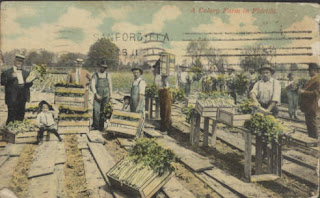 |
| Celery farming was a major occupation in frontier Florida. This postcard is owned by the Sanford Museum and displayed on the Central Florida Memory website. |
Each September, we observe Labor Day. A lot of interesting facts about how Floridians labored in the late 19th century are in the 1890s U.S. Census records. Some highlights:
- A huge chunk - 76.4% - of the farms in Florida were cultivated by owners in 1890. In 1880, the percentage had been 69.1%
- Manufacturing and other industry more than tripled over the same decade. In Florida, products had a gross value of $18.2 million, compared to $5.5 million in 1880.
- 13,927 Floridians were employed in manufacturing and industry in 1890, compared to 5,504 in 1880.
Women predominated within certain fields, primarily in the needle trades. On the national level, women made up:
- 81.4% of the workforce making corsets
- 78.8% of the employees making shirts
- 73.4% of the employees producing millinery and lace goods
Nationally, men made up more than 95% of the workforce in each of the following industries: agricultural implements, brick and tile, cooperage, cutlery and edge tools, flouring and grist mill products, foundry and machine shop products, leather, painting and paper hanging, and saddlery and harness.
Depressingly, 13.7% of tobacco-industry employees were children, as was 10.6% of the cotton-goods workforce. I was somewhat heartened to see that children made up only 2.7% of the workforce, overall, in 1890, compared to 5.6% in 1880.
Also depressing was the wage disparity between men and women. The following Florida examples are illustrative of how workers fared in other parts of the nation. Per job classification, average annual earnings in 1890 in Florida were:
- Officers, firm members, clerks: men, $762; women, $443 ($11,200 in 2014 dollars)
- Operatives, skilled and unskilled: men, $419; women, $304; children, $114
- Pieceworkers: men, $626; women, $347; children, $120
Women did earn more than men in a few industries. These examples are from a national perspective. Women earned $720 a year in the "safes and vaults" industry, while men got only $566. And a job called "oilcloth, enameled," paid women $643 a year, and men $536. By the way, the $720 was the highest pay I saw for a woman, and it equates to about $18,200 in modern dollars.
Neither of those jobs appears to have been a mainstay in Florida in 1890. Of women 10 and older in Florida who listed jobs in the 1890 census:
- 47.3% were in domestic and personal service
- 37.0% worked in agriculture, fishing, and mining
- 4.5% were in professional service
- 1.5% were in trade and transportation
Of working men ages 10 and older in Florida in 1890:
- 51.1% worked in agriculture, fishing, and mining
- 17.0% were in domestic or personal service
- 13.2% were in trade and transportation
- 13.2% were in manufacturing and mechanical industries
- 3.8% were in professional service
In Part 2, we'll take a look at some of the specific jobs that occupied Floridians in 1890, and at the number of people who worked at them. Then, as now, construction industries boomed, but there were some niche fields. For example, 11 people reported jobs as piano and organ makers and tuners.

No comments:
Post a Comment